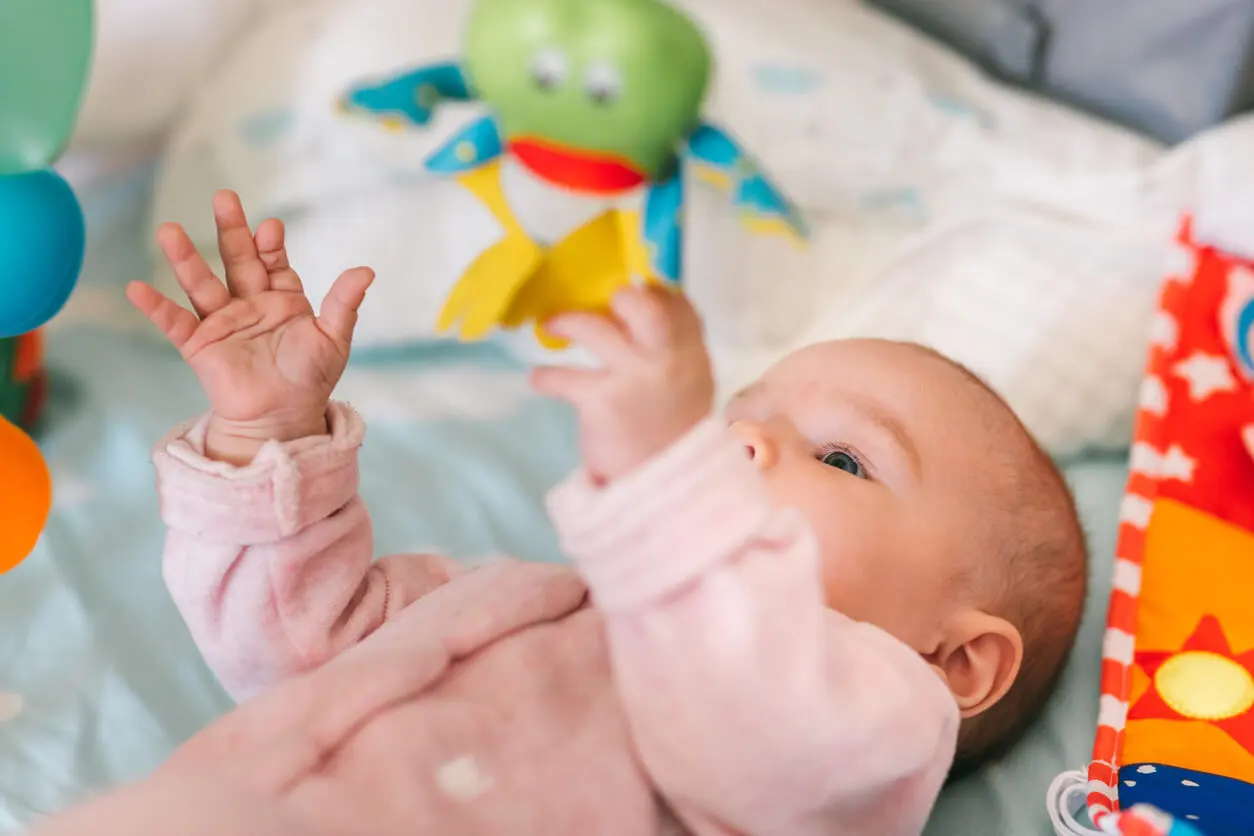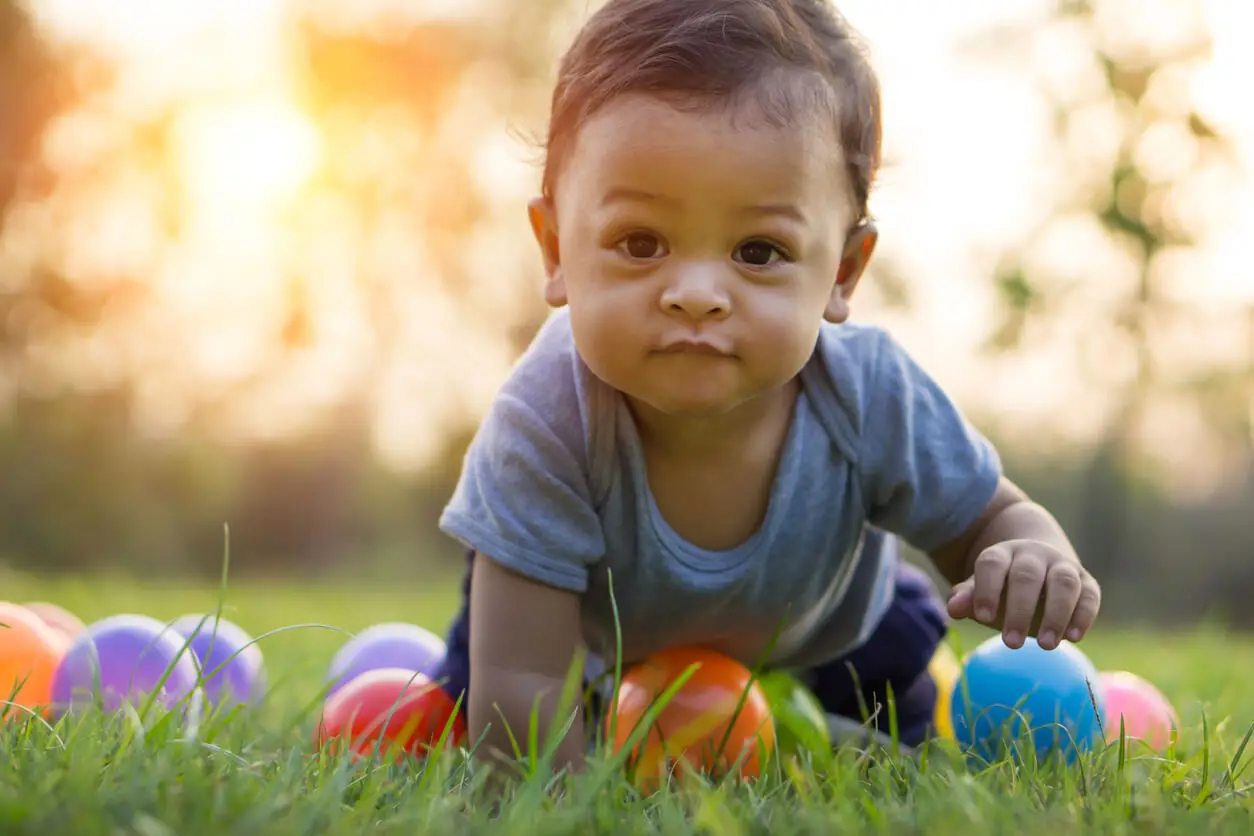Baby's Vision Development: How Does it Happen?


Reviewed and approved by the nurse Leidy Mora Molina
The development of a baby’s vision is a process that makes great strides in the first year of life. Although each child evolves at his or her own pace, the truth is that they all have a similar pattern.
A baby’s vision is very limited at the beginning of life. In fact, sight is the least developed sense at the time of birth. The newborn has a very low visual acuity, but in a few weeks noticeable changes occur.
At each visit to the pediatrician, the professional will examine the progress. He or she should make sure that everything is progressing as expected.
A baby’s vision development begins in the womb
It is important to note that a baby’s vision development begins in the womb. Most visual skills are processed in the brain and not in the eye, although the eye is the fundamental vehicle for the ability.
At only 10 weeks gestation, the so called vestibulo-ocular reflex. This allows the automatic response of the eyes when there is a change in the position of the head. If the pregnant mother performs regular physical activity, she stimulates this reflex in the fetus.
On the other hand, low birth weight is associated with an increased risk of vision problems in the baby.
We think you may also enjoy reading this article: What’s “Baby Talk” and How Does it Benefit Babies?
Newborn vision
The vision of the newborn baby is still very precarious. The cells in the retina and brain are not fully developed. In fact, the baby is not born with sight as such, but with the ability to learn to see.
He cannot focus on close objects and cannot see very far away. It is sensitive to bright light, but after only a few weeks it is also attracted to large shapes and bright colors. It also further develops its central vision, which allows it to focus better on objects that are right in front of it.
Within a few days of birth, the baby prefers to look at the mother’s face rather than at a stranger’s. That is why it is important for the mother to be able to see the baby’s mother’s face. Therefore, it is important that the mother does not change her appearance too much in that first month, as her little one is learning to recognize her.
After one week of birth, the baby can distinguish yellow, red, orange and green. A little later, he will be able to see blue and violet. Mobiles with large figures and bright colors stimulate the baby’s vision.

From 2 to 4 months
At 2 months, it is common for the baby’s eyes to look misaligned, as if he/she has strabismus. This is normal and corrects itself in a short time.
If it persists, you should consult your pediatrician about it. In any case, the child is already able to follow a nearby moving object with his eyes.
During this stage, there is a great advance in the baby’s vision. The child tries to reach with his hands the objects he sees, even if they are moving. At around 3 or 4 months, the baby no longer has to move his head to follow an object with his eyes.
His perception of light is more acute, so it is advisable to lower the intensity of lights while he sleeps. To stimulate her vision, it is good to change the position of the crib and have the mother talk to her while she moves around.
From 5 to 8 months
At 5 months, the baby’s vision has reached an important development. At this age, he completes depth perception, that is, the ability to detect how close or far away an object is. They are also able to see the world in three dimensions.
Coordination between the eyes and hands is much improved. They locate and touch objects more quickly.
Can recognize parents, even if they are on the other side of the room. They remember what an object is just by seeing a part of it.
At 6 months, they should have an eye exam. The pediatrician can detect whether your baby’s vision is normal or there are incipient signs of nearsightedness, farsightedness, or astigmatism. This exam should not be skipped.
Like this article? You may also like to read: When and How to Add Cucumber to Your Baby’s Diet?
From 9 to 12 months
The major advance in baby’s vision during this stage is the refinement of the ability to judge distances. As this is the age of crawling and first steps, it is not uncommon to see them picking up and throwing objects around.
At this stage they also develop more awareness of their body. This is reflected in the fact that there is greater coordination between their eyes and movement in general.
This is also the time when the eyes usually acquire their definitive color.
The best way to stimulate the baby’s vision at this stage is by sitting him on the floor and putting lots of toys around him, of different shapes and colors. Also, give him toys that can be assembled and disassembled.

How to know if everything is okay with the baby’s vision?
When there are problems in the baby’s vision, this affects his overall development. Therefore, it is very important to detect any anomaly in time.
To do so, there is nothing better than to comply with pediatric controls, especially if you notice that the child is having any difficulty.
It is necessary to be attentive to the turning of the eyes inward or outward. If they persist after 4 months of age, it is advisable to discuss it with the doctor. Likewise, if the baby has trouble following objects.
Many parents do not perform a complete eye exam on their babies before the age of 1 year. This is a serious mistake. As we have already noted, such an exam should be done by 6 months of age.
It is a good idea to ask your pediatrician about the best way to stimulate your baby’s vision. Although development happens naturally, with the help of parents it is easier to advance in this process. Good eyesight will help your baby perform better in different areas of life.
All cited sources were thoroughly reviewed by our team to ensure their quality, reliability, currency, and validity. The bibliography of this article was considered reliable and of academic or scientific accuracy.
- Bates Souza, M. C. (2016). Comparación de habilidades visual-perceptual (visual espacial, análisis visual, visual motor) y persistencia de reflejos primitivos (Moro, T asimétrico de cuello, T simétrico de cuello y T laberíntico) en niños nacidos a término y prematuros.
- Maldonado Chapa, F. (2021). Análisis cuantitativo de acuerdo a la edad de la ganancia del reflejo vestíbulo-ocular (VOR) mediante Video Head Impulse Test (VHIT) en una población sana (Doctoral dissertation, Universidad Autónoma de Nuevo León).
- Schapira, I. T. (2004). Características del desarrollo humano perinatal. Un método para la evaluación del sistema nervioso joven. Revista del Hospital Materno Infantil Ramón Sardá, 23(2), 59-69.
This text is provided for informational purposes only and does not replace consultation with a professional. If in doubt, consult your specialist.








